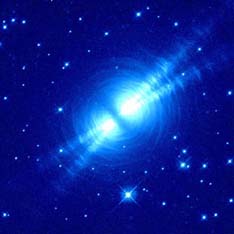AST 309N:
STAR BIZARRE
Astronomy Bizarre:
Stars and Stellar Evolution

AST 309N:STAR BIZARREAstronomy Bizarre:
|
 |
| Instructor: | Harriet Dinerstein | Semester: | Spring 1998 (Unique #43025) |
| Office: | RLM16.224 | Classroom: | RLM 15.216B |
| Office Hours: | MTh 1:30-3:00 p.m. | Class Times: | MWF 11:00-12:00 |
| Phone, E-Mail |
471-3449
harriet@astro.as.utexas.edu |
T.A.: | to be announced |
| PREREQUISITE: | AST 301, 302, 303, or the equivalent (one semester of introductory college-level astronomy for non-science majors) |
| CONTENT AND LEVEL: | The AST 309 courses are follow-up electives to the introductory astronomy courses, offered on a wide variety of topics. AST 309N focuses on stars and stellar evolution, including such exotic phenomena as solar neutrinos, brown dwarfs, planets around other stars, white dwarfs, supernovae, pulsars, and black holes. We will emphasize the understanding of concepts, although you may also be expected to apply simple mathematical principles such as taking ratios. This section of AST 309N satisfies the requirement for a lower division course with a substantial writing component (SWC). |
| TEXTS: | The textbooks are "100 Billion Suns: The Birth, Life, and Death of the Stars," by Rudolf Kippenhahn (required) and "Unveiling the Edge of Time: Black Holes, White Holes, and Wormholes," by John Gribbin (recommended; we will not cover all of this material). Both are inexpensive paperbacks, and will be available at the textbook stores. In addition, a set of Instructor's Notes will be kept on 2-hour reserve in the Physics-Math-Astronomy (PMA) library on the ground floor of RLM. Other useful materials will also be kept on reserve at the PMA library. |
| ASSIGNMENTS AND GRADING BASIS: |
The required work and basis for course grade will consist of:
|
| REASON FOR THE WRITING COMPONENT: | Does it surprise you to find an astronomy course with a substantial writing component? It shouldn't! Good writing means effective communication on paper, or, these days, in the form of a text file on a computer. The ability to express one's ideas clearly and succinctly is an important skill for almost any situation and career. Furthermore, writing about new material forces you to confront what you do and what you don't understand: it's often been said that you learn something best when you have to explain it to someone. In this course, we will use writing assignments as tools to focus your understanding of the material as well as for the purpose of developing writing skills. |
| POLICIES: | All assignments are expected to be handed in on time. Late papers will suffer substantial academic penalties, such as down-grading by one letter grade for each two days of lateness and an automatic "fail" for that assignment after one week. Guidelines for the presentation of the assignments will be announced and distributed in advance, and must be followed. For example, term papers must be typed (or computer-printed), double-spaced, stapled, and on standard-size paper. Naturally we expect that all submitted papers are your own work. |
| NOTE: | Be sure that you read the handout called "Memo to Undergraduate Astronomy Students Regarding Astronomy Courses," which gives information on general departmental policies and useful telephone numbers. As mentioned in that handout, your instructor is a working professional who must occasionally go out of town in order to attend meetings or use telescopes. On these dates, another astronomy faculty member will give a lecture or lead a special class activity. |
| TOPICS: |
The following is a list of topics that I plan to cover:
|